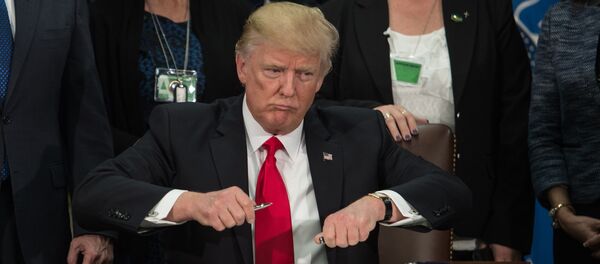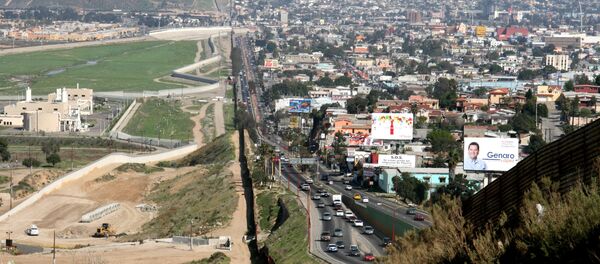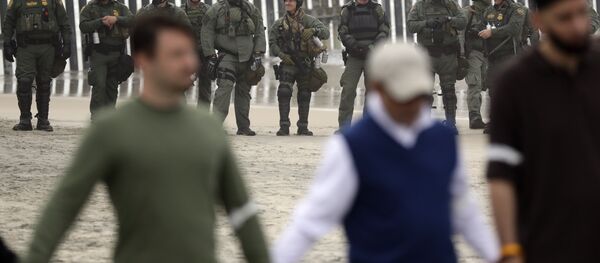Kirstjen Michele Nielsen, an American attorney and national security expert, abruptly resigned on 7 April as the US homeland security secretary. According to Cornell Clayton, a professor at the Washington State University, "this is further evidence of the disarray within the administration over the border crisis and Trump's frustration with what he saw as her inability to clamp down on illegal crossings at the US-Mexico border".
Secretary of Homeland Security Kirstjen Nielsen will be leaving her position, and I would like to thank her for her service….
— Donald J. Trump (@realDonaldTrump) 7 апреля 2019 г.
Trump's Border Wall as Presidential Campaign Issue
"Trump likes the border wall as a campaign issue, but the fact that the situation along the border is getting worse, not better, under his watch is causing concern and confusion in the administration", Clayton told Sputnik, adding that "the dramatic surge in arrests and asylum seekers, many of which are families, along the southern border in recent months has left the administration floundering and searching for quick-fix solutions."
On 5 April, Donald Trump visited the US-Mexico border to take a look at "the first completed section of the new border wall", according to the White House.
Just checked out the new Wall on the Border — GREAT! Leaving now for L.A.
— Donald J. Trump (@realDonaldTrump) 5 апреля 2019 г.
However, as BuzzFeed remarked Friday, the 30-foot, 2.25-mile-long barrier erected in Calexico, California "[was] not actually part of Trump's much-hyped border wall", but merely a replacement of "an old fencing that was made of landing mats from the Vietnam War".
"You do realise that this portion of the wall was planned under Obama, right?" a Twitter user named Ed Krassenstein asked the president.
'Hard-Liners' vs Proponents of Bipartisan Compromise
According to the academic, the southern border controversy continues to escalate within the Trump administration. While "hard-liners like Stephen Miller want to double down on tough rhetoric and "tough policies", there are those who "want to find some bipartisan solution to the boarder crisis and to immigration policies more generally", Clayton said. He added that Trump's son-in-law, Jared Kushner, was "trying to negotiate a broader immigration deal with Democrats behind the scenes".
"The confusion became crystal clear this week", the professor opined. "Trump threatened to close the border with Mexico, but was then forced to back away from that position just six days later by Congressional Republicans and others in the administration who know it would be economically disastrous".
"It could mean all trade" with Mexico, Trump told reporters in Florida, while commenting on the issue. "We will close it for a long time."
However, according to the Guardian's estimates, a complete shutdown would cost the US billions of dollars in trade, about $137 billion of which would be in food imports.
Trump 'Has Been His Own Worst Enemy'
Clayton believes that "this policy is likely to only to worsen the situation by exacerbating the very conditions in those countries making so many people flee in the first place".
"The political problem for the president is that the surge in the flow of arrests and asylum seekers (and the humanitarian crises unfolding) on the border is making him look weak and ineffectual on his signature issue", the professor highlighted.
For their part, Democrats continue to turn a blind eye to the border issue and refuse "to propose their own plans to address the crisis", he said.
"In many ways, the president has been his own worst enemy", the academic opined. "The outdated hardline deterrence and punishment models (such as a border wall, zero tolerance, expedited deportation), that were developed more than a decade ago to stop Mexicans from coming over the border for jobs, are ill-suited and ineffective in deterring asylum-seeking families who are fleeing violence and misery".
According to the academic, that won't be an easy task for the Trump administration to work out a bipartisan approach to migration problem since this opportunity was "poisoned by Trump in December and January, when he shut down the federal government for a record 35 days to try to force congressional funding for his border wall".
Trump sought $5.7 billion from Congress to fulfil his project. After this effort failed the US president declared a nation state of emergency in March to secure the authority and resources to build the wall. When both the Democrats-controlled House of Representatives and the Republican-led Senate passed the legislation to revoke the emergency, Trump vetoed it.
As a result, on 5 April, the House Democrats filed a federal lawsuit seeking to prevent the US president from going around the US Congress to fund the much-discussed wall, arguing that he "overstepped" his constitutional powers.
The views and opinions expressed by the speaker do not necessarily reflect those of Sputnik.







